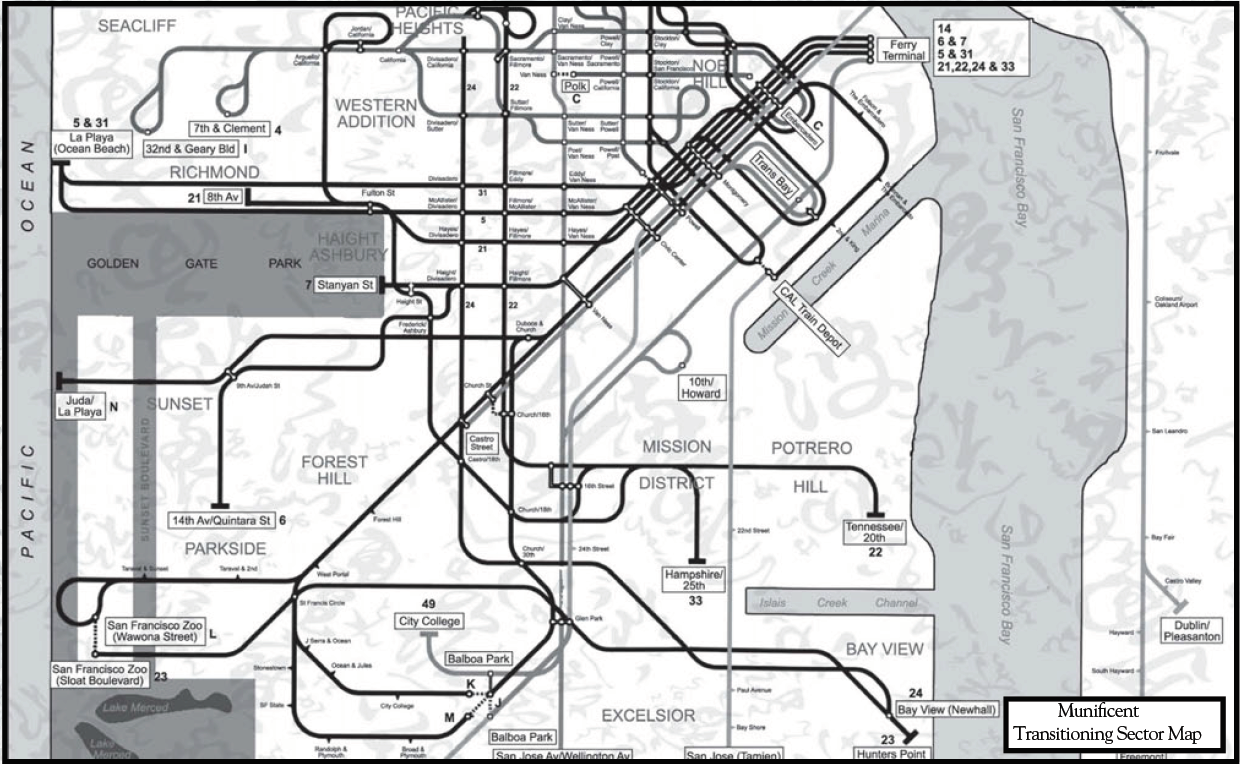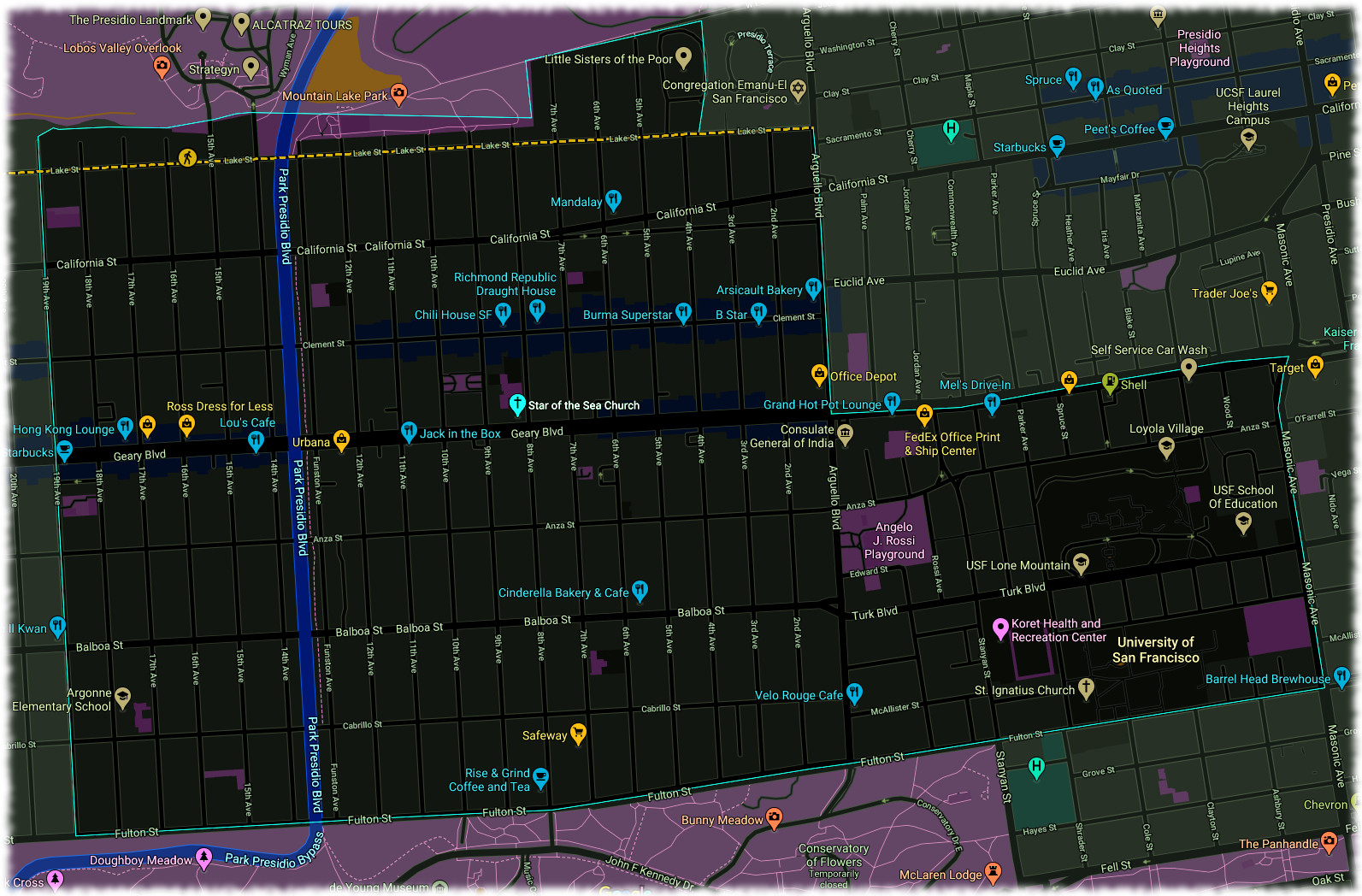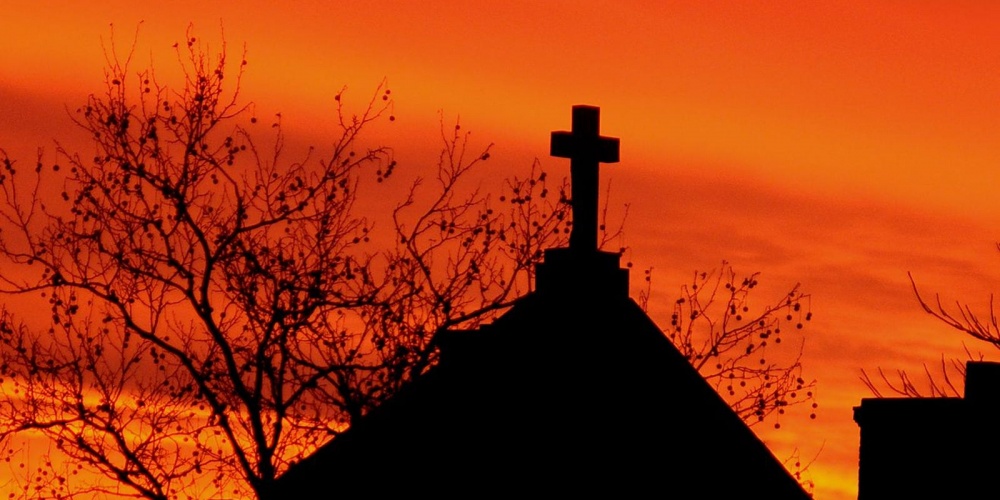San Francisco
Contents
- 1 Quote
- 2 Appearance
- 3 City Device
- 4 Climate
- 5 Districts
- 6 Demonym
- 7 Economy
- 8 Geography
- 9 History
- 10 Population
- 11 Arenas
- 12 Attractions
- 13 Bars and Clubs
- 14 Cemeteries
- 15 City Government
- 16 Crime
- 17 Citizens of the City
- 18 Current Events
- 19 Fortifications
- 20 Galleries
- 21 Holy Ground
- 22 Hospitals
- 23 Hotels & Hostels
- 24 Landmarks
- 25 Maps
- 26 Mass Media
- 27 Monuments
- 28 Museums
- 29 Parks
- 30 Private Residences
- 31 Restaurants
- 32 Ruins
- 33 Schools
- 34 Shopping
- 35 Telecommunications
- 36 Theaters
- 37 Transportation
- 38 Mages
- 39 Vampires of the City
- 40 Kuei-jin
- 41 Deceased or Missing
- 42 Websites
- 43 Errata
Quote
"San Francisco is 49 square miles surrounded by reality." -- Paul Kantner of Jefferson Starship
Appearance
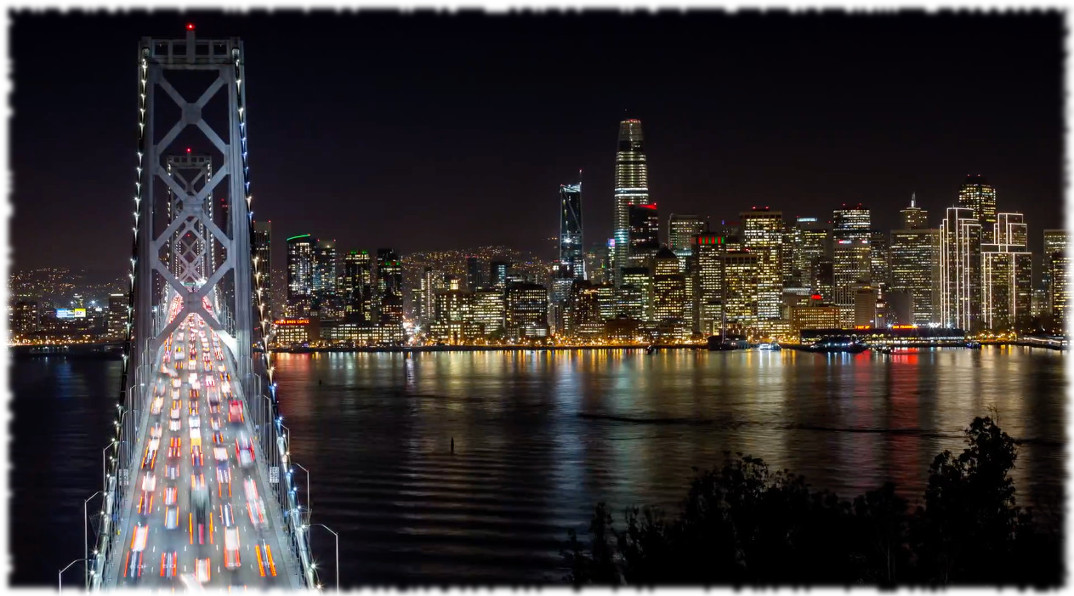
"No city invites the heart to come to life as San Francisco does. Arrival in San Francisco is an experience in living." -- William Saroyan, Armenian-American novelist
City Device
Climate
San Francisco has a warm-summer Mediterranean climate (Köppen Csb) characteristic of California's coast, with moist mild winters and dry summers. San Francisco's weather is strongly influenced by the cool currents of the Pacific Ocean on the west side of the city, and the water of San Francisco Bay to the north and east. This moderates temperature swings and produces a remarkably mild year-round climate with little seasonal temperature variation.
Fog is a regular feature of San Francisco summers.
Among major U.S. cities, San Francisco has the coolest daily mean, maximum, and minimum temperatures for June, July, and August. During the summer, rising hot air in California's interior valleys creates a low pressure area that draws winds from the North Pacific High through the Golden Gate, which creates the city's characteristic cool winds and fog. The fog is less pronounced in eastern neighborhoods and during the late summer and early fall. As a result, the year's warmest month, on average, is September, and on average, October is warmer than July, especially in daytime.
Because of its sharp topography and maritime influences, San Francisco exhibits a multitude of distinct microclimates. The high hills in the geographic center of the city are responsible for a 20% variance in annual rainfall between different parts of the city. They also protect neighborhoods directly to their east from the foggy and sometimes very cold and windy conditions experienced in the Sunset District; for those who live on the eastern side of the city, San Francisco is sunnier, with an average of 260 clear days, and only 105 cloudy days per year.
Temperatures reach or exceed 80 °F (27 °C) on an average of only 21 and 23 days a year at downtown and San Francisco International Airport (SFO), respectively.[96] The dry period of May to October is mild to warm, with the normal monthly mean temperature peaking in September at 62.7 °F (17.1 °C). The rainy period of November to April is slightly cooler, with the normal monthly mean temperature reaching its lowest in January at 51.3 °F (10.7 °C). On average, there are 73 rainy days a year, and annual precipitation averages 23.65 inches (601 mm). Variation in precipitation from year to year is high. Above average rain years are often associated with warm El Niño conditions in the Pacific while dry years often occur in cold water La Niña periods. In 2013 (a "La Niña" year), a record low 5.59 in (142 mm) of rainfall was recorded at downtown San Francisco, where records have been kept since 1849. Snowfall in the city is very rare, with only 10 measurable accumulations recorded since 1852, most recently in 1976 when up to 5 inches (130 mm) fell on Twin Peaks.
Districts
Inner Richmond
Places of Interest
- Star of the Sea Church -- Deconsecrated Parish
Demonym
Economy
Geography
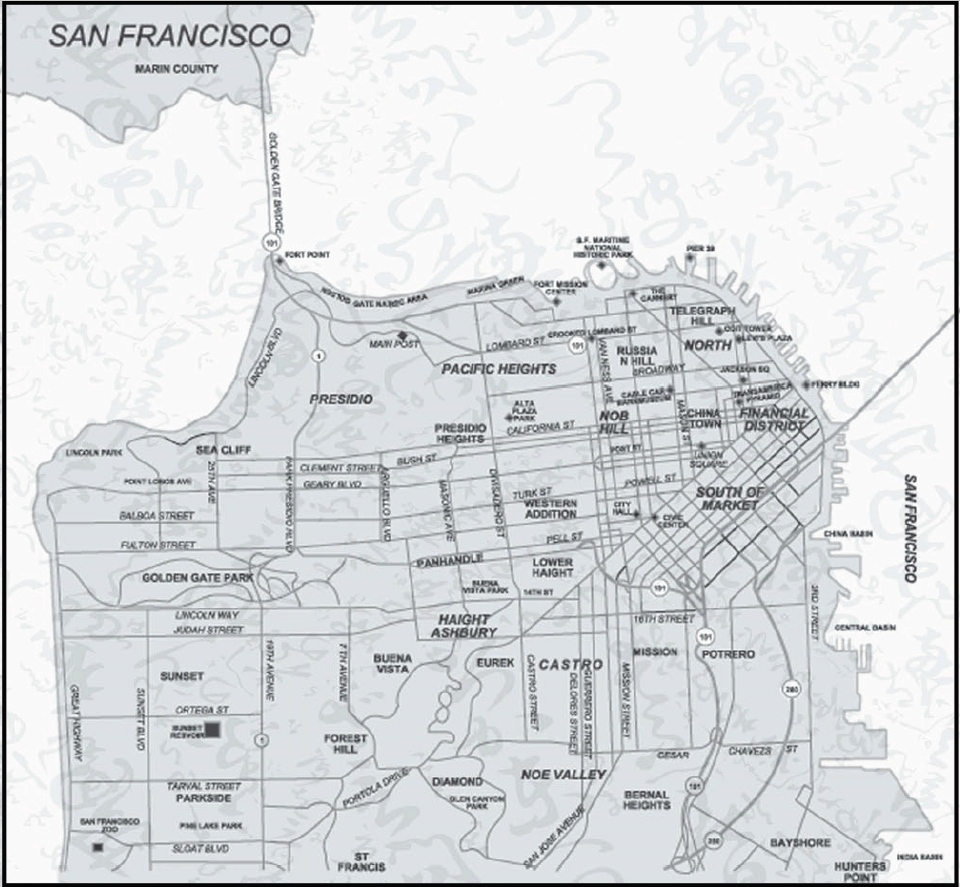
Whoever after due and proper warning shall be heard to utter the abominable word "Frisco",
which has no linguistic or other warrant, shall be deemed guilty of High Misdemeanour, and
shall pay into the Imperial Treasury as penalty the sum of twenty-five dollars. -- Emperor Norton
San Francisco is located on the West Coast of the United States at the north end of the San Francisco Peninsula and includes significant stretches of the Pacific Ocean and San Francisco Bay within its boundaries. Several picturesque islands—Alcatraz, Treasure Island and the adjacent Yerba Buena Island, and small portions of Alameda Island, Red Rock Island, and Angel Island—are part of the city. Also included are the uninhabited Farallon Islands, 27 miles (43 km) offshore in the Pacific Ocean. The mainland within the city limits roughly forms a "seven-by-seven-mile square", a common local colloquialism referring to the city's shape, though its total area, including water, is nearly 232 square miles (600 km2).
There are more than 50 hills within the city limits. Some neighborhoods are named after the hill on which they are situated, including Nob Hill, Potrero Hill, and Russian Hill. Near the geographic center of the city, southwest of the downtown area, are a series of less densely populated hills. Twin Peaks, a pair of hills forming one of the city's highest points, forms an overlook spot. San Francisco's tallest hill, Mount Davidson, is 928 feet (283 m) high and is capped with a 103-foot (31 m) tall cross built in 1934. Dominating this area is Sutro Tower, a large red and white radio and television transmission tower.
The nearby San Andreas and Hayward Faults are responsible for much earthquake activity, although neither physically passes through the city itself. The San Andreas Fault caused the earthquakes in 1906 and 1989. Minor earthquakes occur on a regular basis. The threat of major earthquakes plays a large role in the city's infrastructure development. The city constructed an auxiliary water supply system and has repeatedly upgraded its building codes, requiring retrofits for older buildings and higher engineering standards for new construction. However, there are still thousands of smaller buildings that remain vulnerable to quake damage. USGS has released the California earthquake forecast which models earthquake occurrence in California.
San Francisco's shoreline has grown beyond its natural limits. Entire neighborhoods such as the Marina, Mission Bay, and Hunters Point, as well as large sections of the Embarcadero, sit on areas of landfill. Treasure Island was constructed from material dredged from the bay as well as material resulting from the excavation of the Yerba Buena Tunnel through Yerba Buena Island during the construction of the Bay Bridge. Such land tends to be unstable during earthquakes. The resulting soil liquefaction causes extensive damage to property built upon it, as was evidenced in the Marina district during the 1989 Loma Prieta earthquake. Most of the city's natural watercourses, such as Islais Creek and Mission Creek, have been culverted and built over, although the Public Utilities Commission is studying proposals to daylight or restore some creeks.
Neighborhoods
The historic center of San Francisco is the northeast quadrant of the city anchored by Market Street and the waterfront. It is here that the Financial District is centered, with Union Square, the principal shopping and hotel district, and the Tenderloin nearby. Cable cars carry riders up steep inclines to the summit of Nob Hill, once the home of the city's business tycoons, and down to the waterfront tourist attractions of Fisherman's Wharf, and Pier 39, where many restaurants feature Dungeness crab from a still-active fishing industry. Also in this quadrant are Russian Hill, a residential neighborhood with the famously crooked Lombard Street; North Beach, the city's Little Italy and the former center of the Beat Generation; and Telegraph Hill, which features Coit Tower. Abutting Russian Hill and North Beach is San Francisco's Chinatown, the oldest Chinatown in North America.[88][89][90][91] The South of Market, which was once San Francisco's industrial core, has seen significant redevelopment following the construction of Oracle Park and an infusion of startup companies. New skyscrapers, live-work lofts, and condominiums dot the area. Further development is taking place just to the south in Mission Bay area, a former railroad yard, which now has a second campus of the University of California, San Francisco and Chase Center, which opened in 2019 as the new home of the Golden State Warriors.
West of downtown, across Van Ness Avenue, lies the large Western Addition neighborhood, which became established with a large African American population after World War II. The Western Addition is usually divided into smaller neighborhoods including Hayes Valley, the Fillmore, and Japantown, which was once the largest Japantown in North America but suffered when its Japanese American residents were forcibly removed and interned during World War II. The Western Addition survived the 1906 earthquake with its Victorians largely intact, including the famous "Painted Ladies", standing alongside Alamo Square. To the south, near the geographic center of the city is Haight-Ashbury, famously associated with 1960s hippie culture. The Haight is now home to some expensive boutiques and a few controversial chain stores, although it still retains some bohemian character.
North of the Western Addition is Pacific Heights, an affluent neighborhood that features the homes built by wealthy San Franciscans in the wake of the 1906 earthquake. Directly north of Pacific Heights facing the waterfront is the Marina, a neighborhood popular with young professionals that was largely built on reclaimed land from the Bay.
In the south-east quadrant of the city is the Mission District—populated in the 19th century by Californios and working-class immigrants from Germany, Ireland, Italy, and Scandinavia. In the 1910s, a wave of Central American immigrants settled in the Mission and, in the 1950s, immigrants from Mexico began to predominate. In recent years, gentrification has changed the demographics of parts of the Mission from Latino, to twenty-something professionals. Noe Valley to the southwest and Bernal Heights to the south are both increasingly popular among young families with children. East of the Mission is the Potrero Hill neighborhood, a mostly residential neighborhood that features sweeping views of downtown San Francisco. West of the Mission, the area historically known as Eureka Valley, now popularly called the Castro, was once a working-class Scandinavian and Irish area. It has become North America's first gay village, and is now the center of gay life in the city. Located near the city's southern border, the Excelsior District is one of the most ethnically diverse neighborhoods in San Francisco. The predominantly African American Bayview-Hunters Point in the far southeast corner of the city is one of the poorest neighborhoods and suffers from a high rate of crime, though the area has been the focus of several revitalizing and controversial urban renewal projects.
The construction of the Twin Peaks Tunnel in 1918 connected southwest neighborhoods to downtown via streetcar, hastening the development of West Portal, and nearby affluent Forest Hill and St. Francis Wood. Further west, stretching all the way to the Pacific Ocean and north to Golden Gate Park lies the vast Sunset District, a large middle class area with a predominantly Asian population.[98] The northwestern quadrant of the city contains the Richmond, also a mostly middle-class neighborhood north of Golden Gate Park, home to immigrants from other parts of Asia as well as many Russian and Ukrainian immigrants. Together, these areas are known as The Avenues. These two districts are each sometimes further divided into two regions: the Outer Richmond and Outer Sunset can refer to the more western portions of their respective district and the Inner Richmond and Inner Sunset can refer to the more eastern portions.
Many piers remained derelict for years until the demolition of the Embarcadero Freeway reopened the downtown waterfront, allowing for redevelopment. The centerpiece of the port, the Ferry Building, while still receiving commuter ferry traffic, has been restored and redeveloped as a gourmet marketplace.
History
Population
- -- City (883,305) - 2018
- -- Metro (4,729,484) - 2018
- -- CSA (9,666,055) - 2018
Arenas
Attractions
Bars and Clubs
- -- The Way Down -- A club known for its mixed supernatural clientèle.
- -- Laura - Waitress at the The Way down
- -- Dracula's Daughter -- A Kindred club that has admitted a number of other supernaturals.
- -- Gold Club -- High End Gentlemen's club
Cemeteries
- Star of the Sea Catholic Church
- Pastor Father Andrew
- John (Gravedigger and Handyman)
- Jacob (Gravedigger and Handyman)
- Star of the Sea Catholic Church
City Government
Crime
In 2011, 50 murders were reported, which is 6.1 per 100,000 people. There were about 134 rapes, 3,142 robberies, and about 2,139 assaults. There were about 4,469 burglaries, 25,100 thefts, and 4,210 motor vehicle thefts. The Tenderloin area has the highest crime rate in San Francisco: 70% of the city's violent crimes, and around one-fourth of the city's murders, occur in this neighborhood. The Tenderloin also sees high rates of drug abuse, gang violence, and prostitution. Another area with high crime rates is the Bayview-Hunters Point area. In the first six months of 2015 there were 25 murders compared to 14 in the first six months of 2014. However, the murder rate is still much lower than in past decades. That rate, though, did rise again by the close of 2016. According to the San Francisco Police Department, there were 59 murders in the city in 2016, an annual total that marked a 13.5% increase in the number of homicides (52) from 2015.
Gangs
Several street gangs operate in the city, including MS-13, the Sureños and Norteños in the Mission District,. African-American street gangs familiar in other cities, including the Crips, have struggled to establish footholds in San Francisco, while police and prosecutors have been accused of liberally labeling young African-American males as gang members. Criminal gangs with shotcallers in China, including Triad groups such as the Wo Hop To, have been reported active in San Francisco. In 1977, an ongoing rivalry between two Chinese gangs led to a shooting attack at the Golden Dragon restaurant in Chinatown, which left 5 people dead and 11 wounded. None of the victims in this attack were gang members. Five members of the Joe Boys gang were arrested and convicted of the crime. In 1990, a gang-related shooting killed one man and wounded six others outside a nightclub near Chinatown. In 1998, six teenagers were shot and wounded at the Chinese Playground; a 16-year-old boy was subsequently arrested.
Peace Officers
The San Francisco Police Department was founded in 1849.
The portions of Golden Gate National Recreation Area located within the city, including the Presidio and Ocean Beach, are patrolled by the United States Park Police.
The San Francisco Fire Department provides both fire suppression and emergency medical services to the city.
The city operates 22 public "pit stop" toilets.
Citizens of the City
Current Events
Fortifications
Galleries
Holy Ground
Hospitals
- Saint Francis Memorial Hospital
- Cynthia Spicer - High Security Terrorist attack survivor
Hotels & Hostels
Landmarks
- Alcatraz Island -- is home to the abandoned prison, the site of the oldest operating lighthouse on the West Coast of the United States, early military fortifications, and natural features such as rock pools and a seabird colony (mostly western gulls, cormorants, and egrets).
- Three Brother's Storage -- Owns several storage units inside office buildings in financial district
Maps
Mass Media
Monuments
Museums
Parks
Private Residences
Restaurants
Ruins
Schools
Shopping
- Doc's Comics & Collectables -- Owned by Dr. Diego "Doc" Soto, a PhD in both Criminal Justice and Civil War History, author of books on Alcatraz, comic book store owner, writer, and artist.
Telecommunications
Theaters
Transportation
Mages
- -- Penny Dreadful -- Born as Penelope Anne Drizkowski, is a mage and signature character of the Hollow Ones.
Vampires of the City
Gangrel
- -- Logan Wakefield -- Gangrel wanderer (Former PC)
 -- Liborio Tosetti (PC) [Morgan]
-- Liborio Tosetti (PC) [Morgan]
Brujah
- 200px --Angelica White -- (PC)
Toreador
- Lorraine - Owner of The Way Down club
- Quon Corbyn - Teen Hacker
Malkavian
- --Annabel Nolan -- (Former PC)
Daughters of Cacophony
- Everett Young -- Anarch Musician
Barony of the Sea
Baron Toc's Crew
- -- Sebastian Toc -- Brujah Leader
- -- Katia -- Sebastian's Second
- -- Cord Brashen -- Sebastian's Muscle
- -- Bashe -- Toreador member of Sebastian's crew
- -- Alban -- Sebastian's Accountant
Barony of the Bridge
Kuei-jin
Jade Dragons
Golden Dragons
- -- Zen -- Baron - Leader of the Golden Dragons, Bone Flowers
Deceased or Missing
- -- Sara Anne Winder -- Ventrue Duke of San Francisco. {missing}
- -- Vannevar Thomas -- Former Ventrue prince of the city, {deceased}
Websites
https://environment.ambient-mixer.com/
https://washingtonmonthly.com/magazine/julyaugust-2012/the-power-broker/ {How politics really work in San Francisco}
https://en.wikipedia.org/wiki/Alcatraz_(TV_series)

